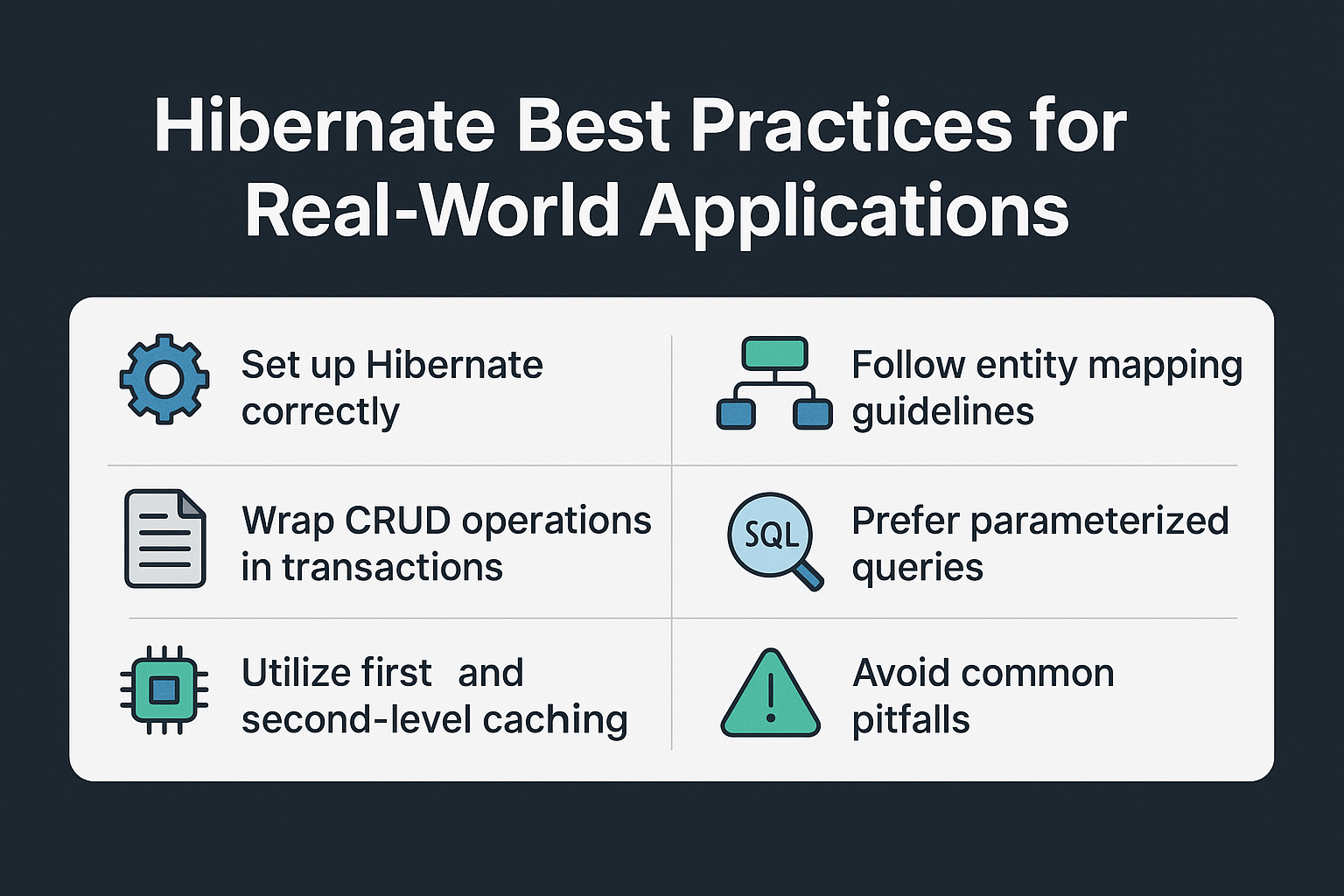Hibernate is one of the most widely used ORM (Object-Relational Mapping) frameworks in the Java ecosystem. It simplifies database operations by mapping Java objects to relational tables. While Hibernate reduces boilerplate code, poor usage can lead to performance bottlenecks, data inconsistencies, and production headaches.
This tutorial covers Hibernate best practices for building reliable, scalable, and maintainable real-world applications. Whether you’re working on a SaaS product, enterprise system, or microservices, these practices will help you write production-ready Hibernate code.
Setting Up Hibernate Correctly
Dependencies
<dependency>
<groupId>org.springframework.boot</groupId>
<artifactId>spring-boot-starter-data-jpa</artifactId>
</dependency>
<dependency>
<groupId>org.postgresql</groupId>
<artifactId>postgresql</artifactId>
<scope>runtime</scope>
</dependency>
Configuration
spring.jpa.hibernate.ddl-auto=validate
spring.jpa.show-sql=false
spring.jpa.properties.hibernate.format_sql=true
spring.jpa.properties.hibernate.jdbc.batch_size=50
spring.jpa.properties.hibernate.order_inserts=true
spring.jpa.properties.hibernate.order_updates=true
✅ Best Practice: Avoid create-drop or update in production. Use migration tools like Flyway or Liquibase.
Entity Mapping Best Practices
Use Proper Identifiers
@Entity
public class Employee {
@Id
@GeneratedValue(strategy = GenerationType.IDENTITY)
private Long id;
private String name;
}
- Prefer
GenerationType.IDENTITYorSEQUENCEdepending on the database. - Avoid natural keys as primary keys.
Define Relationships Carefully
@Entity
public class Department {
@Id
@GeneratedValue(strategy = GenerationType.IDENTITY)
private Long id;
@OneToMany(mappedBy = "department", cascade = CascadeType.ALL, fetch = FetchType.LAZY)
private List<Employee> employees = new ArrayList<>();
}
- Always use lazy fetching unless eager fetching is absolutely necessary.
- Be careful with
CascadeType.ALLon large relationships.
Analogy: Lazy loading is like ordering food only when you need it rather than bringing the entire menu to your table.
CRUD Best Practices
Save Entities
Session session = sessionFactory.openSession();
Transaction tx = session.beginTransaction();
Employee emp = new Employee();
emp.setName("Alice");
session.save(emp);
tx.commit();
session.close();
Update Entities
session.beginTransaction();
Employee emp = session.get(Employee.class, 1L);
emp.setName("Updated Name");
session.update(emp);
session.getTransaction().commit();
Delete Entities
session.beginTransaction();
Employee emp = session.get(Employee.class, 1L);
session.delete(emp);
session.getTransaction().commit();
✅ Best Practice: Always wrap CRUD operations in transactions.
Query Best Practices
HQL Example
List<Employee> list = session.createQuery("FROM Employee WHERE department.name = :dept", Employee.class)
.setParameter("dept", "Engineering")
.list();
Criteria API
CriteriaBuilder cb = session.getCriteriaBuilder();
CriteriaQuery<Employee> cq = cb.createQuery(Employee.class);
Root<Employee> root = cq.from(Employee.class);
cq.select(root).where(cb.equal(root.get("name"), "Alice"));
List<Employee> employees = session.createQuery(cq).getResultList();
✅ Best Practice: Prefer parameterized queries to prevent SQL injection.
Caching Best Practices
- First-Level Cache: Enabled by default per session.
- Second-Level Cache: Configure providers like Ehcache, Infinispan, or Redis.
- Query Cache: Use cautiously; it may increase memory consumption.
@Cacheable
@Entity
public class Employee {
@Id
private Long id;
private String name;
}
Analogy: Caching is like reusing saved answers instead of asking the same question repeatedly.
Performance Tuning
-
Use batch fetching:
spring.jpa.properties.hibernate.default_batch_fetch_size=20 -
Avoid N+1 select problem by using
JOIN FETCH:String hql = "SELECT d FROM Department d JOIN FETCH d.employees"; -
Use DTO projections for large queries instead of fetching entire entities.
Real-World Integration with Spring Boot
@Repository
public interface EmployeeRepository extends JpaRepository<Employee, Long> {
List<Employee> findByName(String name);
}
Spring Boot simplifies repository and transaction management while keeping Hibernate configuration minimal.
Common Pitfalls
- Using
EAGERfetching unnecessarily. - Relying on
SessionFactoryincorrectly in multi-threaded environments. - Poor transaction management → inconsistent data.
- Overusing
CascadeType.ALL→ accidental deletions. - Ignoring batch operations → performance issues.
Best Practices Checklist
- Use lazy fetching by default.
- Always wrap operations in transactions.
- Configure second-level cache carefully.
- Avoid
create-dropin production. - Use DTOs for read-heavy queries.
- Monitor SQL queries with tools like p6spy.
- Use migrations (Flyway/Liquibase) for schema management.
📌 Hibernate Version Notes
Hibernate 5.x
- Uses
javax.persistencepackage. - Relies heavily on XML or annotation configuration.
- Legacy Criteria API still supported.
Hibernate 6.x
- Migrated to Jakarta Persistence (
jakarta.persistence). - Improved query API with more SQL-standard alignment.
- Better support for
SessionFactoryand bootstrapping.
Conclusion and Key Takeaways
Hibernate is a powerful ORM, but misuse can degrade performance and reliability. By following these best practices, developers can ensure efficient, scalable, and maintainable applications.
Key Takeaway: Use Hibernate’s strengths — caching, ORM mapping, and query APIs — wisely, while avoiding anti-patterns like eager fetching and poor transaction handling.
FAQ: Expert-Level Questions
1. What’s the difference between Hibernate and JPA?
Hibernate is an ORM framework that implements the JPA specification.
2. How does Hibernate caching improve performance?
By reducing database hits with first- and second-level caching.
3. What are the drawbacks of eager fetching?
It loads too much data unnecessarily, slowing down queries.
4. How do I solve the N+1 select problem in Hibernate?
Use JOIN FETCH, entity graphs, or batch fetching.
5. Can I use Hibernate without Spring?
Yes, but Spring Boot simplifies setup and transaction handling.
6. What’s the best strategy for inheritance mapping?
Depends: SINGLE_TABLE for performance, JOINED for normalization.
7. How does Hibernate handle composite keys?
With @EmbeddedId or @IdClass.
8. How is Hibernate 6 different from Hibernate 5?
Hibernate 6 uses Jakarta Persistence, modernized query API, and improved SQL compliance.
9. Is Hibernate suitable for microservices?
Yes, but configure caching and transactions carefully per service.
10. When should I not use Hibernate?
Avoid for high-performance OLAP systems or schema-less databases.
